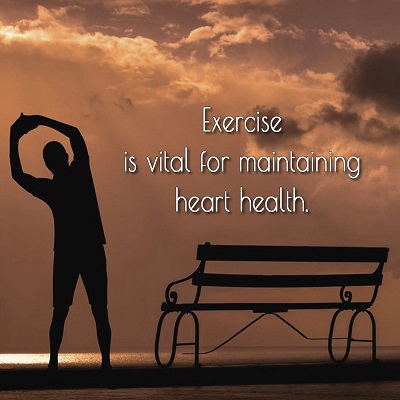 Cardiovascular diseases can be life-threatening. It is critical to keep a healthy heart and avoid the dangers of heart problems, high blood pressure, high blood sugar, or stroke. Making regular exercise a part of your daily routine for life and being physically active can go a long way in preventing most heart health problems.
Cardiovascular diseases can be life-threatening. It is critical to keep a healthy heart and avoid the dangers of heart problems, high blood pressure, high blood sugar, or stroke. Making regular exercise a part of your daily routine for life and being physically active can go a long way in preventing most heart health problems.
One of the most important organs in our bodies, the heart, is also a muscle that gets stronger and healthier with regular physical exercise. But you don’t have to be an athlete to be heart-healthy. You just have to make exercise a part of your daily routine for the rest of your life. Even walking for at least 30 minutes every day will be hugely beneficial to your long-term health.
While physical exercise is really important for the heart, not all exercises are created equal. Some exercises may focus on giving your body other benefits like flexibility or balance, but not dramatically contribute to helping you to keep a healthy heart for life.
According to Kerry Stewart Ed. D., John Hopkins exercise physiologist, “aerobic exercises and resistance training are the most important for heart health.”
Aerobic Exercises
Aerobic exercise is identified as the most beneficial exercise for an individual’s cardiovascular health. It is also known as “cardio” and it helps improve circulation, which results in lower blood pressure and heart rate. It utilizes the repetitive contraction of a large group of muscles, making the person’s heart beat faster. It also increases aerobic fitness, which can be measured by a treadmill test. Aerobic exercise helps the heart pump better, aiding cardiac output.
30 minutes of daily aerobic exercise for a minimum of five days a week is considered the ideal. Aerobic exercise reduces the risk of developing type 2 diabetes, and for those already diagnosed with diabetes, helps them to manage their blood glucose level. Some examples of aerobic exercises are running, brisk walking, cycling, swimming, playing sports. The best type of aerobic exercises are heart-pumping activities conducted for a minimum of 150 minutes per week.
Resistance Training
Resistance training is also known as strength work. It helps to strengthen the muscles, by making them work against a force or weight. People carrying more body fat can reduce fat more effectively and create leaner muscle mass with resistance training, as it has a more specific effect on body composition.
Combined with aerobic exercise, it can work even better as there are studies that support that combining both exercises (aerobic exercise and resistance training) can help raise HDL (good cholesterol) and minimize LDL (bad cholesterol). This reduces the risk of developing cardiovascular health problems.
There are different forms of resistance training, including the use of free weights, resistance bands, weight machines, and even the person’s own body weight (e.g. yoga). Training 2-3 times a week can prove to be the most beneficial and effective for people who want to get fitter and healthier with resistance training.
Stretching (for Flexibility) and Balance Exercises
It may not first appear that flexibility exercises or balancing exercises directly benefit an individual’s heart health. But both can go a long way in benefitting cardiovascular fitness, through how it benefits our musculoskeletal health. Flexibility helps us to do our exercises more effectively and avoid injuries. With sufficient flexibility, we may prevent joint pain, cramps, or unnecessary injuries that could potentially arise from more strenuous exercises like aerobic exercise or resistance training.
Flexibility exercises play an important role as they put our bodies in the right condition for conducting either aerobic exercises or resistance training without unnecessary strain or injury.
Balancing exercises on the other hand help to maintain stability and prevent falls that could likely happen also when conducting strenuous exercises. Achieving balance and improved flexibility are still very important in making sure our body can sustain the cardiovascular exercises it needs to stay fit and healthy.
Stretching exercises may not always be the most interesting, but they can be done in the comfort of your home with some videos from the internet, making them really convenient and easy to learn. Flexibility exercises and balancing exercises are both important in building up and strengthening our cardiovascular health.






